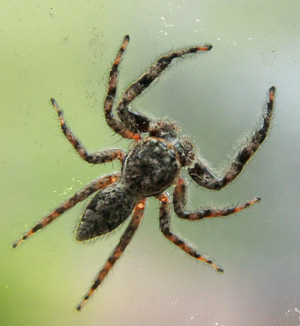
Anyone who gardens has undoubtedly encountered spiders at one time or another. Spiders are arthropods belonging to the order Araneae in the class Arachnida. The name arachind comes from Greek mythology. The princess Arachne challenged the goddess Athene to a weaving contest. When Arachne lost, she was turned into a spider and destined to weave forever.There are more than 35,000 named species of spiders in the world with 3,000 of them making their home in North America.
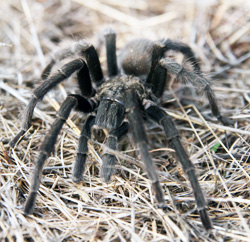
Spiders differ from insects in that spiders have 8 legs, not 6; they also have only 2 body regions (a cephalothorax and abdomen) instead of 3 (head, thorax, abdomen); and they lack wings and antennae, both of which insects possess. Finally, spiders possess unique organs beneath their abdomen called spinnerets. These 6 spinnerets allow the spider to produce silk throughout their entire life while only a few insects can produce silk, and then only during specific life stages.
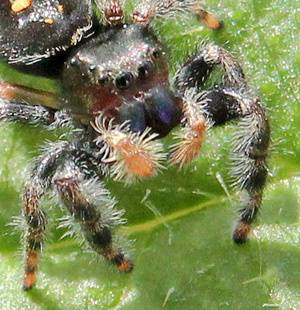
Spiders have unique mouthparts comprised of chelicerae, or jaws, that end in fangs. Although most spiders are venomous, they are harmless to humans with a few exceptions—the black widow and the brown recluse being the most common. The venom produced by spiders is used to paralyze and kill their prey. Spiders rarely attack humans unless provoked and even then they are more likely to flee than fight. People often mistakenly blame spiders for bites caused by fleas, ticks, or mites. Most spiders don’t possess mouthparts
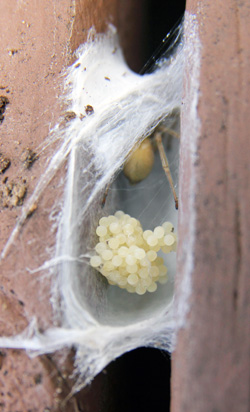
capable of breaking human skin.
Most spiders complete a single generation in one year. However, there are a few species that may live for several years. A typical spider’s life cycle begins when egg masses are laid in debris in the fall. These eggs may overwinter as is or the individual eggs within may hatch into spiderlings that remain protected in the egg mass until spring. After laying an egg mass, the female spider dies. In the spring, spiderlings move from their overwintering site by crawling or ballooning, a process by which they produce a silken thread on which they are carried by the wind.

Spiders feed on a wide variety of insects and are therefore considered beneficial in the garden when they eat pests including aphids, caterpillars, cucumber beetles, flies, grasshoppers, leafhoppers, plant bugs, and thrips. However, most spiders are opportunistic and eat whatever they catch, rather than targeting specific pests, and may capture beneficial insects such as bees or tachinid flies.

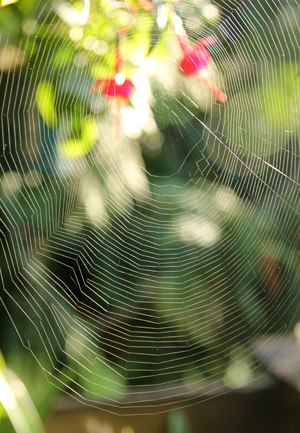
Because of their generally beneficial nature, garden spiders should be conserved. Avoid the use of broad-spectrum insecticides or insecticides containing pyrethrum or synthetic pyrethroids. Other practices that can help spiders include leaving a portion of the garden covered in organic mulch or planting a cover crop to provide an overwintering site for egg masses. Spiders capture their prey in three main ways. The largest group constructs a web of some sort to capture their prey. These web spinners typically are found on or near their webs, laying in wait for their unsuspecting prey. They are typically more delicate in nature than their wandering relatives. The next most common method is that of the hunting spiders. They are robust and mobile, and do not wait for a meal to come to them but actively track down their prey. Although they do not construct a web to capture their prey, they may construct a silken refuge. The last group is the ambush hunters, who sit motionless until their prey comes within easy grasp and then pounce.
If you’ve ever watched a spider spin a web you were likely impressed by it’s skill and adeptness. To begin construction, a spider sends a single thread out into the breeze until it catches onto something. Next the spider tightens this thread and attaches the originating end to some structure. She then reinforces the original line before dropping down to begin the creation of the first cross-thread. The “Y” shape that results comprises the central hub of the web from which threads are attached to form the radii that make up the web. Spiders are likely some of the best physicists around—capable of determining the exact distance, angle, and tension necessary to construct the perfect trap for their prey.

Some of the most common spiders found in the garden in Wisconsin are argiope or orb weaver spiders, barn spiders, jumping spiders, wolf spiders, and crab spiders.
-
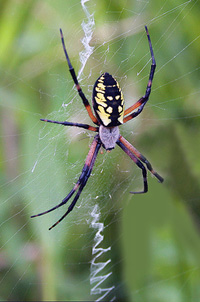
A common yellow and black argiope spider. Argiope (rhymes with calliope) spiders belong to the family Araneidae. The name “argiope” is typically associated with the black & yellow garden spider. They are commonly seen in gardens and fields on shrubbery and tall flowers in late summer and fall. They are moderate to large in size with an unusually large, and often oddly-shaped abdomen, and may be brightly colored. Their webs are particularly large, up to 1 foot in diameter and are characterized by the white zig-zag band of silk that runs down the center of the web. Argiope spiders often wait in their web for their prey to come stumbling or flying in.
-
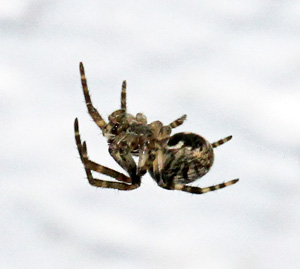
A barn spider hangs upside down on nearly invisible threads of its web under a buildings eaves. Another member of the Araneid family is the barn spider. Barn spiders are relatively large web spinners reaching up to 1 inch in size at maturity and are brownish in color. They spin their webs in shaded areas around buildings, caves, or cliffs. The genus Araneus contains a large number of species that look like marbles—some of which are orange or cream-colored.
-
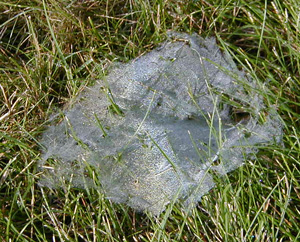
A funnel-shaped grass spider web. Grass spiders are moderately-sized, brownish-grey weavers of funnel-shaped webs. Their webs can often be found around building foundations, on low-growing shrubs, or in lawns. The grass spiders themselves lay in wait in the funnel. A unique characteristic of the webs woven by grass spiders is that the threads are not sticky as they are in the case of barn and argiope spiders, so the funnels are just to direct the prey to the spider instead of entangling it.
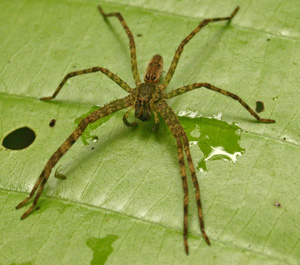
A Costa Rican wolf spider. - The wolf spider is one of the hunting spiders that actively pursues its prey. They are large, brown or grey with white markings, and hairy, resembling small tarantulas. Wolf spiders belong to the family Lycosidae which is derived from the Greek word “lycosa” that means “wolf.” They are ground-dwellers that are active by day or night in a wide range of habitats. Many species burrow into the ground or beneath rocks to wait for their unsuspecting prey.
-

A small yellow crab spider on a flower (L) and closeup (R). Crab spiders get their name because their first four legs are larger than the hind legs and because of their capability of walking forward, backward, or sideways. Unlike the wolf spider, crab spiders don’t actively pursue their prey but rather ambush them as they go walking by. Many species of crab spiders will sit on flowers, hidden in the petals, waiting for victims to fly in.

Crab spider lurking on a purple coneflower (L) and closeup (C), and with a captured fly on a common milkweed flower (R). - Jumping spiders belong to the family Salticidae, which means “to leap.” They may be found indoors as well as out. These nimble acrobats can jump more than 40 times their body length. Because of their highly mobile life style, jumping spiders have the best vision of all spiders. They are medium-sized and compact. They can be drab or brightly colored and are easily identified by their jerky movements.
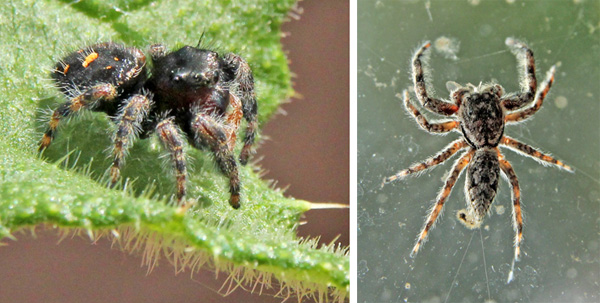
Jumping spiders outdoors (L) and indoors (R).
The closely related daddy long legs, harvestmen or harvest-spiders are not true spiders (arachnids in the order Opiliones, not Araneae) — they have no silk glands and therefore can’t make webs. Most have legs that are really long relative to the size of the body. Unlike spiders, they are not exclusively predators but most are omnivorous or scavengers.

The next time you’re in the garden, look around and see how many different kinds of spiders you can find. Also, keep in mind some of the gardening practices you can do to benefit spiders who in turn will repay you by helping keep some pest insects under control.
– Susan Mahr, University of Wisconsin – Madison





 Aster, Symphyotrichum spp.
Aster, Symphyotrichum spp. Fascinating Fasciation
Fascinating Fasciation Alternatives to Lawn: Groundcovers
Alternatives to Lawn: Groundcovers Marigolds
Marigolds


